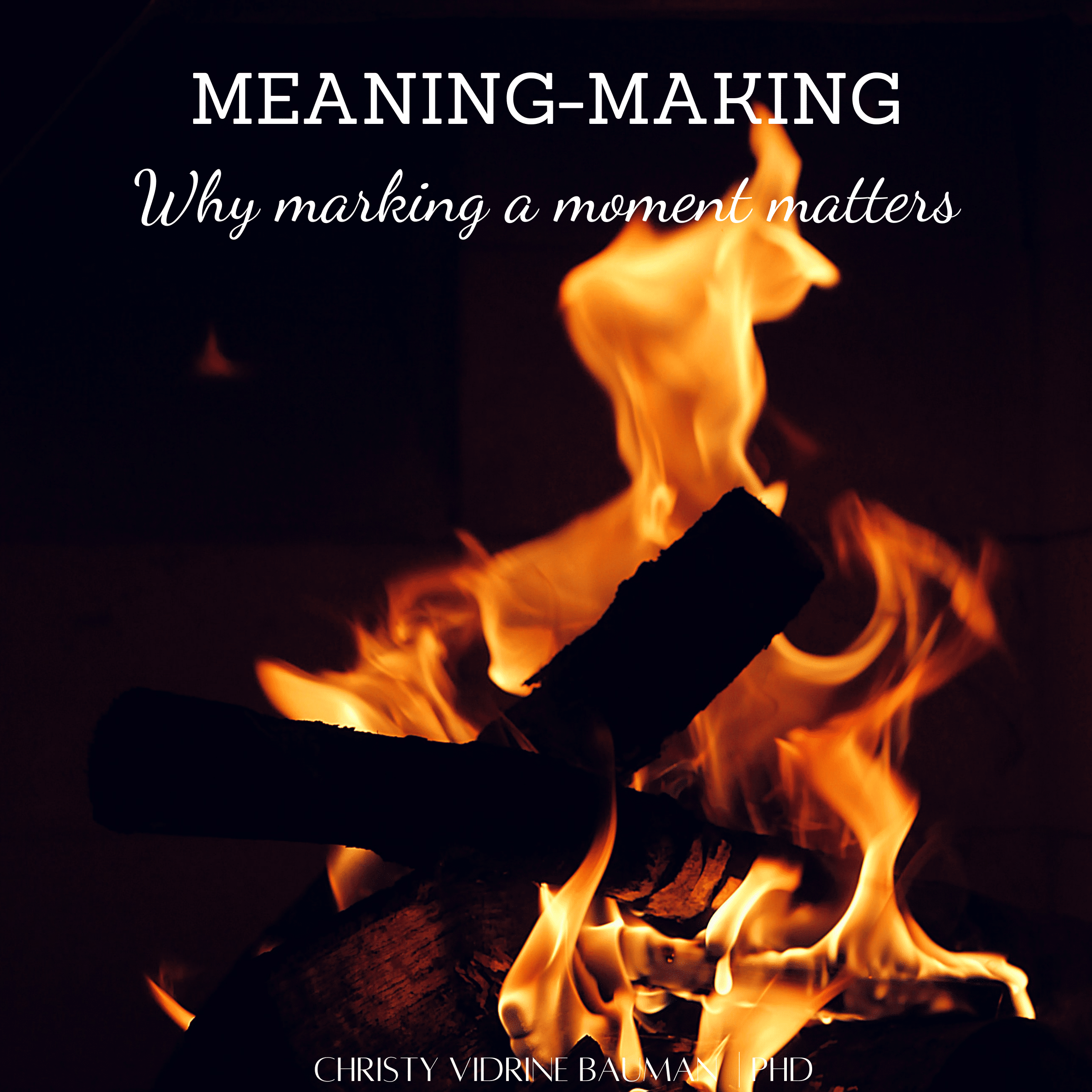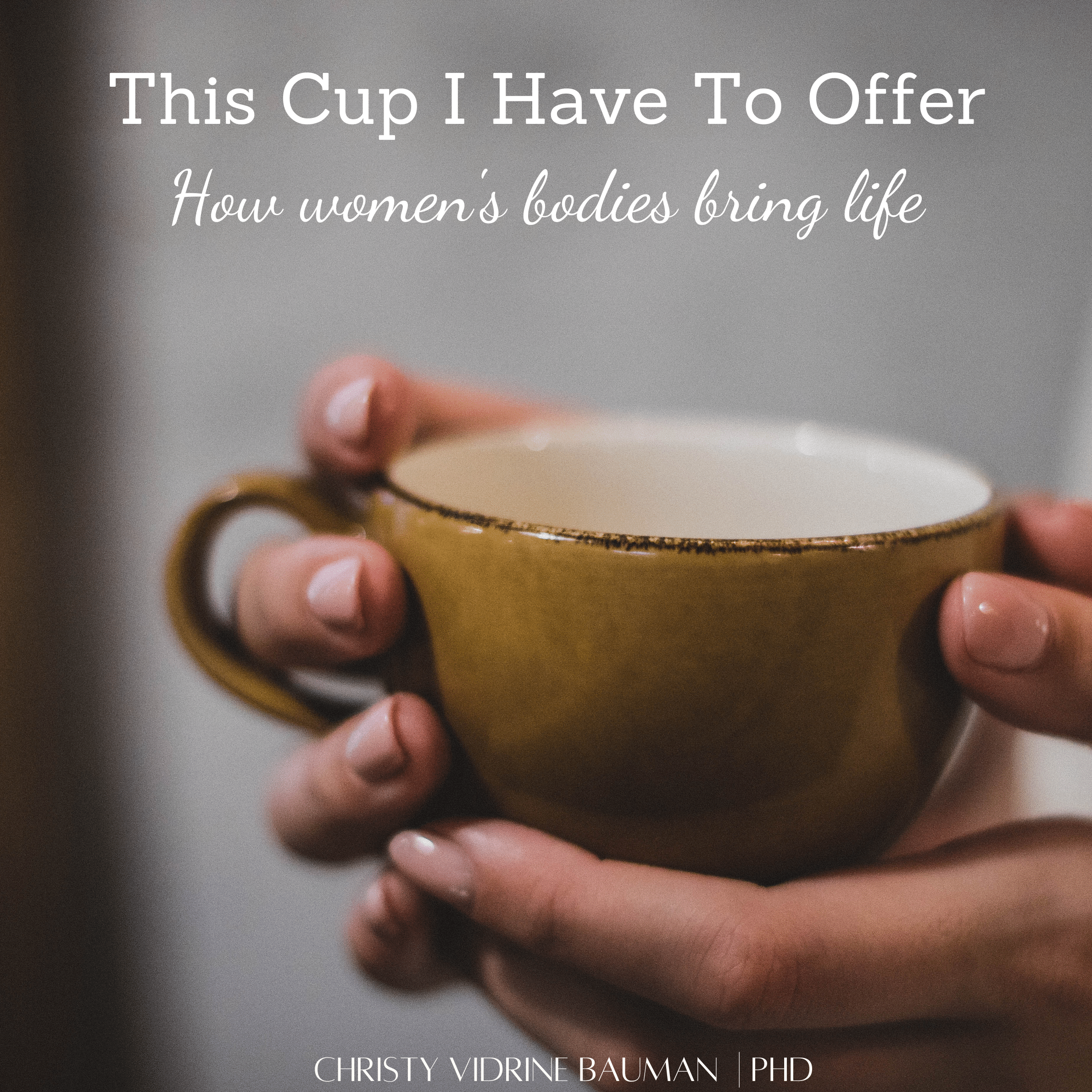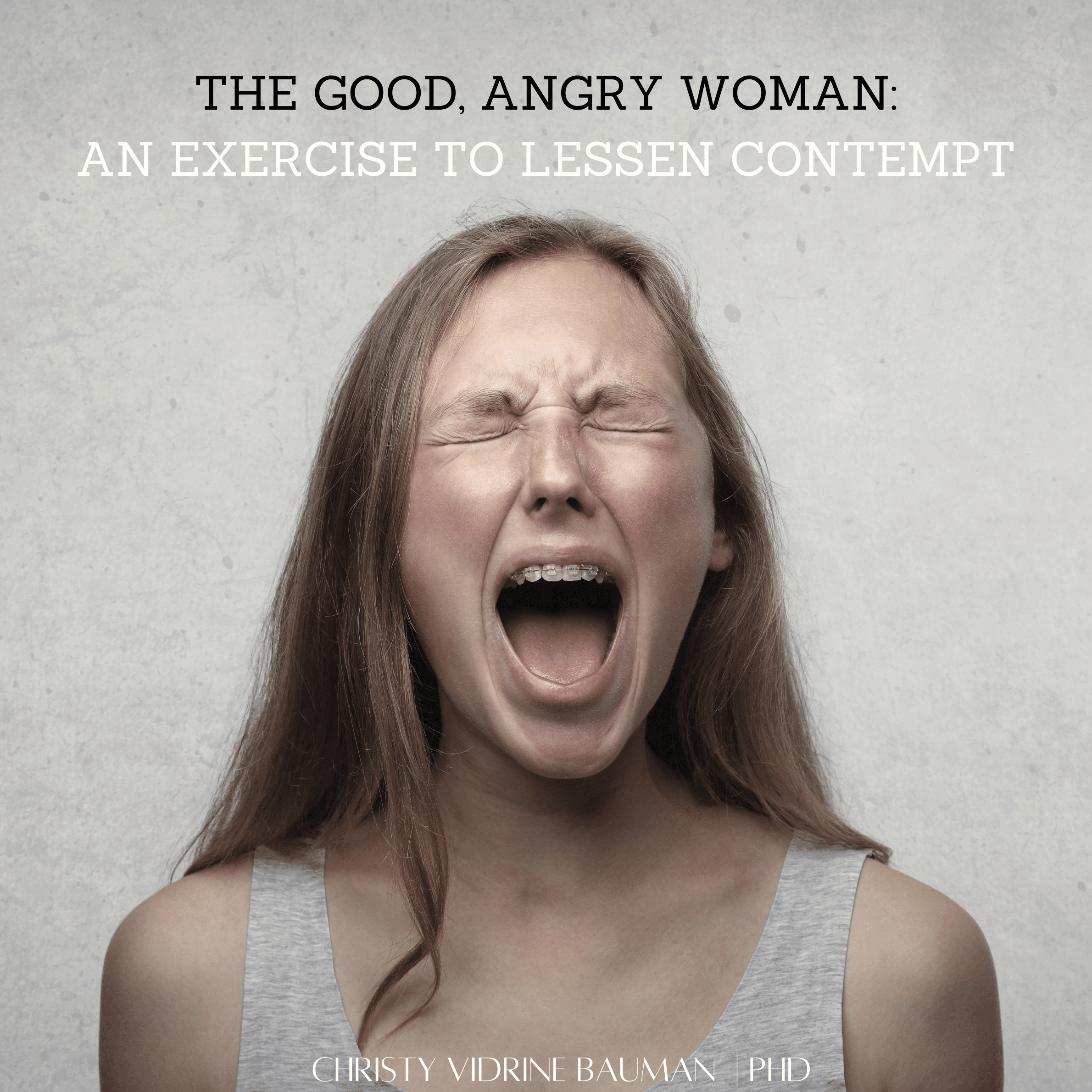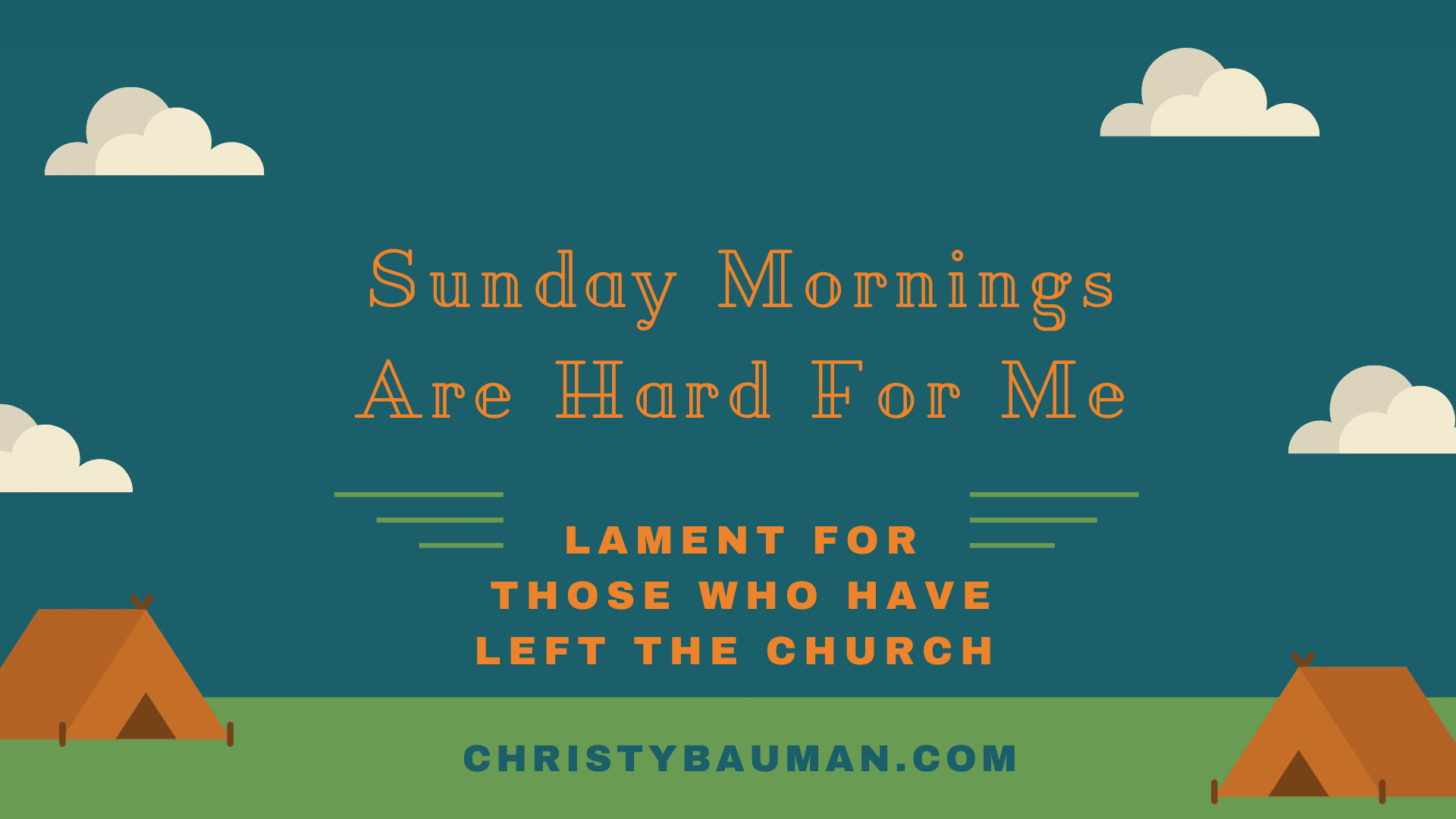Good Friday to Resurrection Sunday: Were You There Waiting in the Dark?
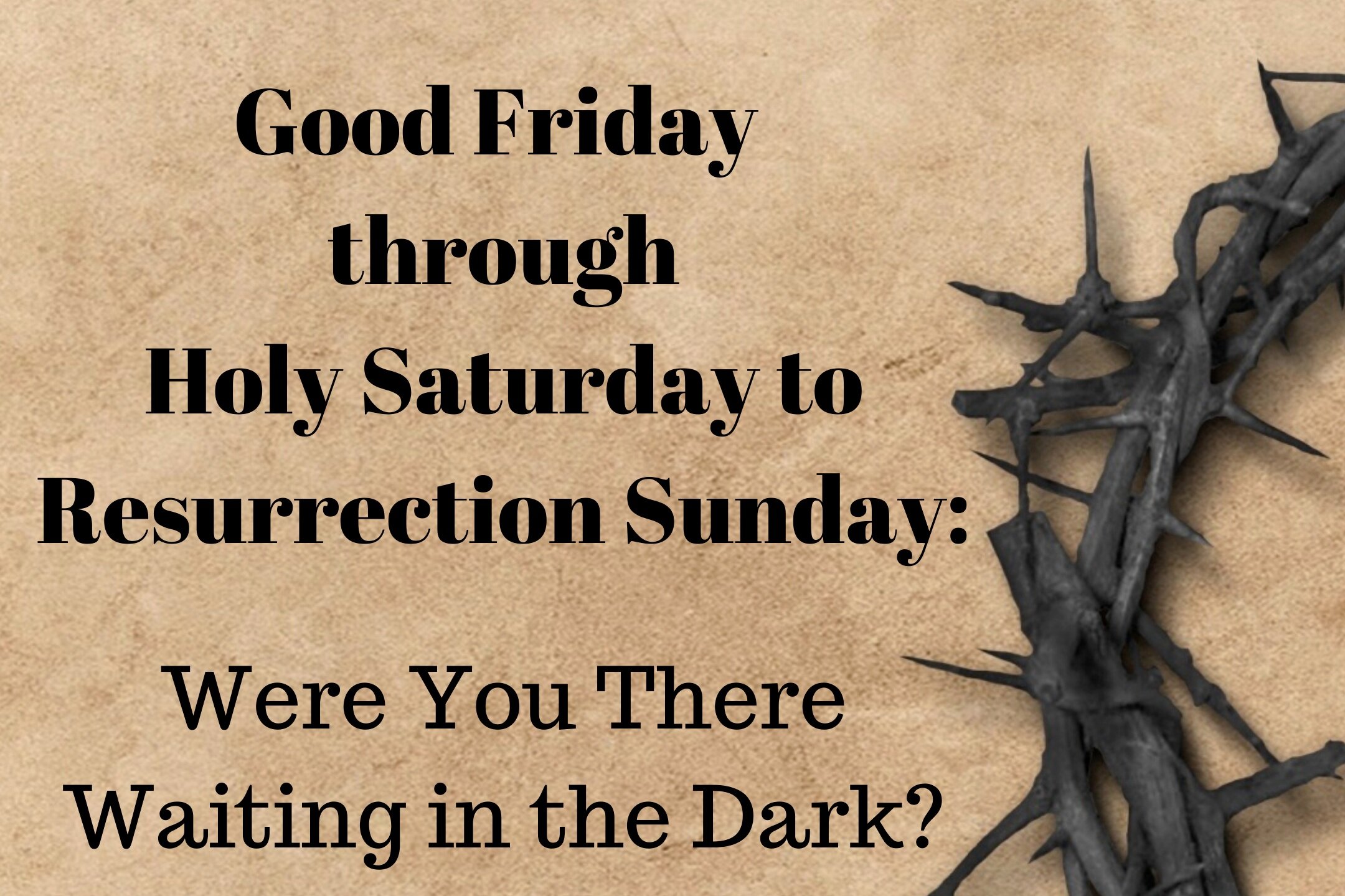
We have an “Easter/Resurrection Manger” set if you will, it consists of rocks, a cross, a clay tomb and an action figure Jesus. (That’s correct, Amazon sells action-figure Jesus dolls and theologically I don’t know how I feel about it). That being said, every year, the week of Easter, we carefully unwrap the clay dried tomb we hand-molded a few years back, the twine wrapped sticks we created into a cross, and the plastic, Gumby-like Jesus figure we purchased. My kids are surprisingly always very excited and intrigued by this small tradition around Easter. My two oldest played with the rocks and put Jesus in and out of the tomb in imaginative conversation. Tonight, I listened to my 5-year-old daughter, Selah tells me how sad Jesus is going to be in the dark tomb alone again this year. I try to remind her that He will be out on Sunday and defeat death with His Resurrection. She isn’t comforted by this thought, she continues to tell me she feels afraid that Jesus will be alone in the dark.
I am reminded of my best work as a therapist which is not to rationalize the other’s perspective but rather to be with them in their fears.
Every time I pass our tomb scene tucked in our stairwell, I think about her words. I know the agony of death and the crucifixion is more than she can understand but as a mental health therapist, I am aware of the different type of agony that comes in loneliness and darkness. The mystery of Christ still beckons me to wonder whether I completely understand why Holy Saturday is so important of a day. A whole day on the church calendar devoted to waiting in hope and hopelessness.
This year, due to COVID-19, we will not be attending a Good Friday service, instead, we will have our own. We will turn off all the lights and stop using electricity and technology at 3 pm to signify when the sky went dark. We will sing acapello the haunting words,
“Where you there when they crucified my Lord?
Where you there when they nailed Him to a tree?
Sometimes, it causes me to tremble, tremble, tremble.
Where you there when they crucified my Lord?
The kids will take Jesus off the cross and place him in the tomb and put the stone in front of our clay tomb. This is Selah’s most hated part, her imagination knows no greater fear than being left alone in the dark tomb. I ask her what would be a kind act on Jesus’ behalf. “We need to leave a nightlight on for him and sing to him.” So we precede to do both, sing the rest of the song and light a candle and leave it glowing near the Easter scene.
“Where you there when they laid Him in the tomb?
Where you there when they laid Him in the tomb?
Sometimes it causes me to tremble, tremble, tremble.
Where you there when they laid Him in the tomb?”
No, I wasn’t there. I have read The Journal of American Medicine Association confirmed the death of Christ (JAMA 1986;255:1455-1463). I also know that women are the first ones to account for Jesus’ tomb being empty and His resurrection before the 500 witnesses. Women weren’t thought to be credible witnesses by Jewish customs, so why did God have a woman at His Son’s tomb? I wasn’t there but I think about it. Especially, on Easter weekend, I think about more than how it must have been to be crucified, I think about what it was to lay in a dark tomb alone. Women’s bodies know that being left alone is hard, and our knowledge leads us to join and be with and bear witness. My experiences with graves are few but haunting. I laid my firstborn’s body in a deeply dug hole in the ground. I buried him with the shirt that I was wearing when they placed him in my arms at the hospital, I wanted him to feel my warmth and remember my smell while his body lay alone in his tomb. I placed flowers and dirt on top of his small casket until he was covered by a heavy blanket of ground and longing grief. It causes me to tremble to even speak of the 8-year-old memory. I was there the next morning at the cemetery grounds, kneeling on the dew-covered grass near his grave. Just in case God wanted to bring him back to life, just in case he felt any sense of abandonment in his flesh, I wanted to be there.
I imagine Mary was no different. The distress of your love left buried alone in the ground. I would have been nowhere else but near his body. So, when the Bible says, Mary was at the tomb Sunday morning, I believe it because I was at my own boy’s grave the very next morning, and the next, and the next. When my daughter says she is worried about Jesus being afraid in the dark tomb alone, I believe her fear - I believe her female body. More than ever I have begun to notice the times’ women were mentioned in the Bible and most of them are in stories of accompaniment with life-giving or burying. Women know the ways of birthing life and birthing death. So, this Good Friday and Holy Saturday, I am not at all surprised by my daughter’s knowledge to accompany Jesus during His time in the tomb. I will teach her the ways of a woman who is learning the craft of accompaniment and birthing death as she reminds me that it matters to even Jesus to not be left alone.
“Where you there when they laid Him in the tomb?
Where you there when the stone was rolled away?
Sometimes it causes me to tremble, tremble, tremble.
Where you there when the stone was rolled away?”
Making Meaning: Marking the Simple Moments Matter in Life
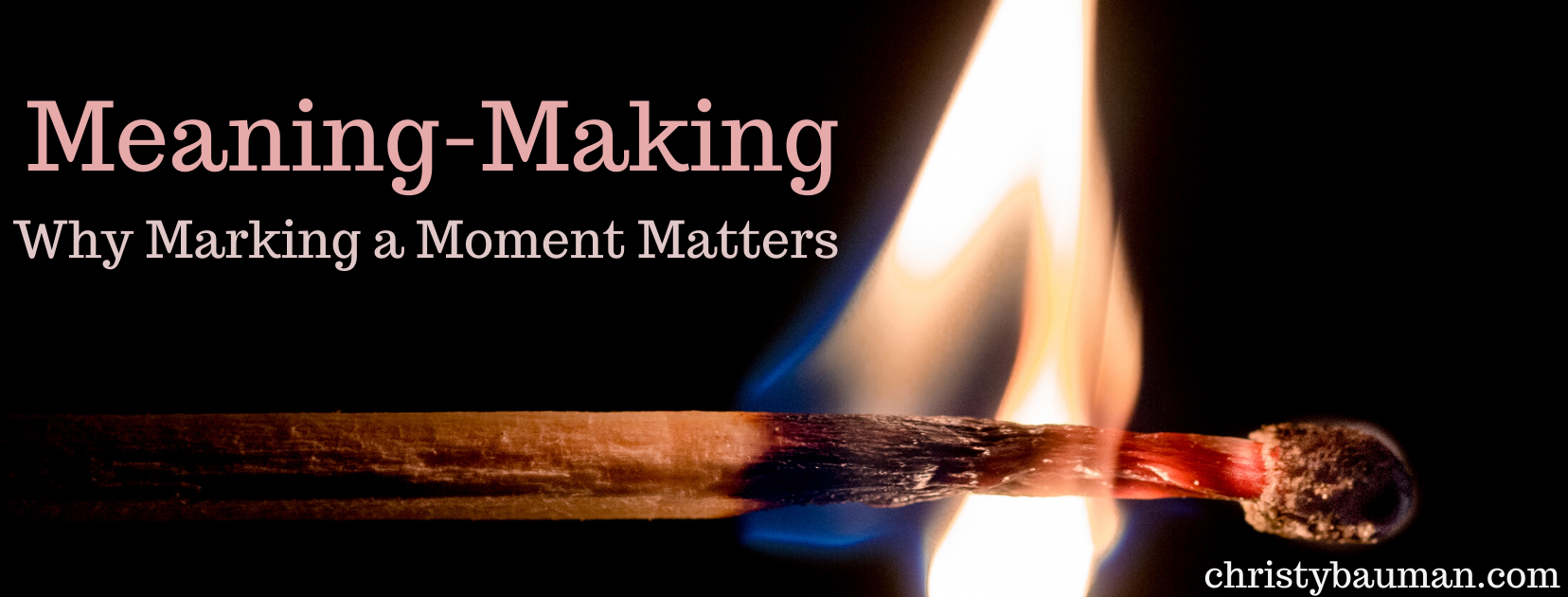
I am restless. My three kids are all quieted and settled for the next hour, and I am well aware this is my only window of time for myself. The barrage of ideas floods my mind: exercise, soak in a bath, watch a show, run an errand, wash clothes, start prepping dinner, go hang out with my partner, finish weeding the garden beds….the list goes on and on. I am acquainted with these moments all too well, and I have trained myself to recognize them and pause.
When I feel restless, I recognize it, stop, take a few breaths and ask myself: What do I need?
What I need most right now in this isolation period of COVID-19 is to get outside whenever possible. I also know that I need to make meaning of the time that is passing by without my active intention. What I am trying to say is that I realize the greatest thing I can do during this outbreak is to isolate my family. By staying home, I help discontinue the spread of this virus and give healthcare workers a chance to catch up. Yet, this feels useless when I so badly want to actively help. Research tells us that making meaning of a situation helps humanize our understanding and psychological health (Park, 2006). My body wants to mark this time somehow, and the next step is to listen to how I might do this. I put my windbreaker and running shoes on, headed for the small wooded path near our house. As I reach for the doorknob to leave, I realize my daughter has my phone and is FaceTiming with her cousin. I feel immediate panic at the thought of leaving the house without my podcasts or audiobooks to bolster an already begrudgingly choice to exercise. There is no time to change my mind, I walk out and face my disappointment head-on.
When being present with one’s self, we often have to push through the disappointment of our comfort-lessness.
The fresh air and hard dirt path seem resistant to welcoming my compartmentalized thoughts - colliding in the infinite space of silence. I heard the words from my conversation with my grandparents yesterday, “If we die, Christy, no one can come to our funeral; the churches are practically shut down”. Their fears feel overwhelming to me, as I think of the thousands within the 70+-year-old demographic who are facing such realities. Community comforts our loneliness and when it's taken away, we find ourselves faced with a loud silence.
Being alone is often an invitation to mark and make-meaning.
I stop to stretch and feel tightness in my calves and if I stay with my body, I can also sense the aging of my knees. What does it mean to be alone with ourselves? What does it feel like to face our aging bodies? I don’t want to think about my own body aging, I run back to my house, climb onto my trampoline and I jump until I can’t catch my breath. Then, I head to my back fence and pick up my garden clippers and fill the fire pit with dead blackberry bushes. Clearing the land feels good to my cooped-up body. I grab matches, light the brush, and let it burn. As I cut back branches, I can feel the need to stop and mark this unprecedented time.
Marking is done by adding intention and presence to the simple acts we are doing.
I then take a match for my grandparents, I light it and watch it burn - I say a prayer for their fear of a lonely death. I light another match for my friend who I know is miscarrying and can’t go to the hospital, I say a prayer. I light a match for a family member who is scared and alone through this time of isolation. I light another match for all the lives that were taken in the past 24 hours and I say a prayer. I can hear the wind chimes in the background, my Pop gave them to me as a way to make the Holy Spirit audible. I lit a last match for the first responders who are working around the clock to serve the sick, the grocery clerks who are stocking food for our families. Finally, I end my time of intention with a deep breath and a whisper, “In Your mercy, hear my prayer”.
Meaning-making consists of warming up to your body’s experience of a situation, stopping to partake in a physical act of marking, and intentionally ending the time.
As I continue to cut down and burn the brush, I feel my body is more at ease, my mind is not running with unaddressed thoughts, I am not irritated about being without my phone or any other comforts, I feel present and at peace with the situation, I am in, because I have been intentional to walk with the body through the process of making meaning of the unknown.
“Lord, grant me the discipline to be alone with myself,
The fortitude to find you there.
Thank you for this very breath I have,
may I use it honorably today.
Selah.”
Further Research on Meaning-Making and Marking Events
Marker events are commonly displayed in acts of ritual, rites of passage, and ceremonies, such as quinceaneras, bar mitzvahs, and other coming-of-age celebrations, weddings, or funerals. Whether they evoke situational meaning or ceremonial meaning, these acts have an important effect on the level of resilience and well-being in a person’s lifespan (Park & Folkman, 1997; Ungar, 2011). Park and Folkman identify two levels of meaning, global and situational, in the Meaning-Making Model. Situational meaning refers to a person’s understanding of a specific instance, while global meaning refers to an individual’s broad orientation and perspective of multiple situations (Park, 2013). The theory of meaning-making has more recently been used in conjunction with narrative and social constructivist therapies as a way to humanize the assessment process and enhance therapeutic change. Meaning-making is used in case studies, clinical vignettes, and therapeutic dialogue. The integration of meaning-making practices into day-to-day talk therapy sessions has shown positive results, and its application has assisted in closing the g
ap between theory and practice (Neimeyer & Raskin, 2000).
References
Park, C.L. & Folkman, S. (1997). Meaning in the context of stress and coping. Review of General Psychology, 1, 115-144.
Neimeyer, R. A., & Raskin, J. D. (Eds.). (2000). Constructions of disorder: Meaning-making frameworks for psychotherapy. Washington, DC, US: American Psychological Association.
http://dx.doi.org/10.1037/10368-000
Park, C. L., & Ai, A. L. (2006). Meaning-making and growth: New directions for research on survivors of trauma. Journal of Loss and Trauma, 11(5), 389-407.
Park, C. L. (2008). Testing the meaning-making model of coping with loss. Journal of Social and Clinical Psychology, 27(9), 970-994.
This Cup I Have To Offer
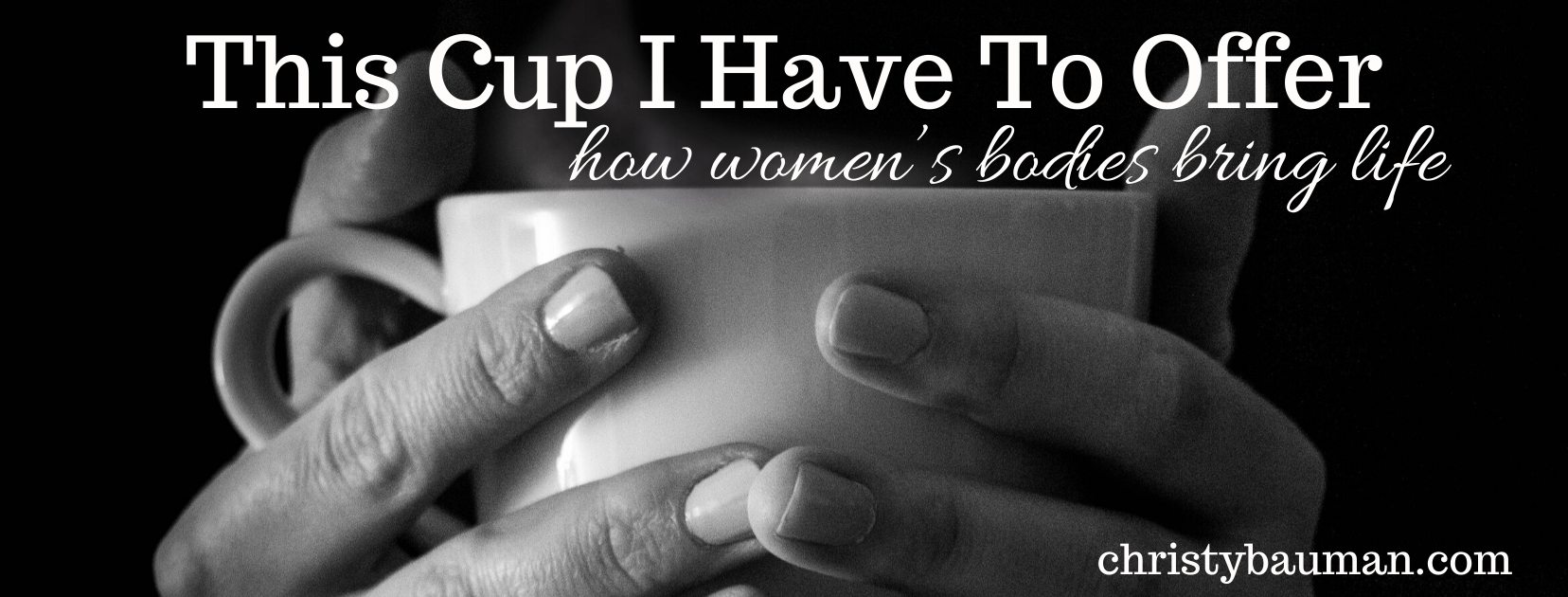
“This cup is My blood, My new covenant with you, each time you drink this cup, remember Me.”
It’s been a long week, come to think of it, it’s been a long month with Covid-19 hitting Seattle by force. We have stayed home, stopped going to school, changed our work schedules, and so when I find myself eating tablespoons of Nutella from the jar, I am not super hard on myself. My relationship with food is always telling me something about how I am doing internally. I always try to listen to what my body is saying, and I am starting to see a pattern when I am PMSing: no desire to have sex, ambivalence with the big things, frustration with the small stuff, bloating, and a lack of care about exercise or sugar intake.
The woman’s uterus instinctively knows how to birth.
A woman’s body, despite whether she has ever physically birthed, knows how to birth, a frame containing a uterus practice monthly for most of her life to birth. My body is whispering or yelling truths to me whenever I start to prepare for birthing. What am I birthing this time around? An anxious month, a celebratory season, another year of life, a separation with a lover, a reckoning with myself… Whatever the birthing, I can always feel the preparation. I keep looking for blood to come, waiting for relief that these feelings are all part of a bigger picture.
Our body was meant to be a trusted friend; if it isn’t, we must mend the trust.
There is a trusted friendship that I want to have with my body, a knowing that we care for each other, a security that we’ve got each other’s back. It is in the moments of disconnect with my body that I feel most alone and out of sorts in the world. It reminds me of what women with an invisible disease would explain as the “foreignness” in their bodies, somehow betrayed by an illness that could kill them all the while their exterior looking healthy. I have known this foreignness with my body when it has carried a lifeless child within my womb while acting as if all were normal and well. Sometimes, in the regular monthly cycles of menstruation, I feel a fraction of this foreignness, like my mood, my cramps, my blood are saying something, and I am not connected to it.
Cyclical bleeding is an invitation to knowing yourself more.
These repeated months over a span of almost 40 years are still invitations to knowing myself anew. After being done with pregnancies, I am noticing a new pattern in the week before my pre-menopausal period. It is as if each time I am preparing to birth something, a physical prompting to allow myself to release and shed blood. It feels more vulnerably close to death and burying. I think I am being invited into the act of burying better than before. These days, there is relief when blood comes. It seems like an explanation, and expression to my internal turmoil, I even find myself overjoyed. In the last three months, when blood comes, I have run into the other room to tell my husband in some sort of excitement. Like, “See, I knew something was up” or “I did it, I birthed another small hardship through this body of mine.” My excitement doesn’t make much sense, but ever since the shame of bleeding has been taken away and the stigma of my period has been removed, I feel free to be curious. What is my body trying to birth each month? It actually becomes a wonder that I start to follow its lead, and I listen.
I approach my bleeding body with shamelessness and curiosity.
This month was about birthing the anxiety and stir-crazy of the coronavirus - my body was sorting through all the feelings of global hardship, financial devastation, and physical sickness. The media, number of cases, and daily changes were exhausting, and my body was telling me that it could feel the weight and could also birth through it. So when the blood came, I was overjoyed, my body had found a way to move through its cycle in such a massive season, and I was grateful. And Bruce Springsteen’s sings,
“There’s a blood, red circle on the cold, dark ground, and the rain is falling down,
church door’s thrown open, the congregation is gone, my city of ruins.
The boarded-up windows, empty streets, my city of ruins.”
What is the state of our globe? What is the state of your body? What is the state of your soul? How does it respond to devastation? How does it react to heartache and loss? When blood comes, I think I can hear your body saying, whispering or yelling,
“Come on rise up,
come on rise up,
come on rise up,
come on rise up.”
Our blood is saying something to you, “Come on, rise up, this cup is my blood, a new covenant.”
May we all be invited into our bleeding as a way of knowing that our bodies are good, and our bodies can metabolize the life/death/life cycle. We should stop and listen to our wise bodies, for they can teach us so very much. If I listen in these moments, to my body, my uterus shedding its lining and pouring itself out, I hear God speaking. Growing up in Catholicism, the first communion was a big deal, a rite of passage in the community that a child could not receive until they were of age and asked Jesus to come into their hearts. My priest taught me that after receiving Jesus in Holy Communion, you must remember that you are carrying Jesus to your homes and schools as Jesus’ mother Mary carried Jesus to her cousin Elizabeth. When you are alone, you have Jesus living in your soul and can tell Him all things. So, I believe my monthly cup of blood is the closest physical representation of Christ, breaking His body and bleeding into a cup and offering it to me as a remembrance that the old is gone, the new has come.
“This cup is My blood, My new covenant with you, each time you drink this cup, come on and rise up and remember Me.”
The Good, Angry Woman: An Exercise to Help Lessen Contempt
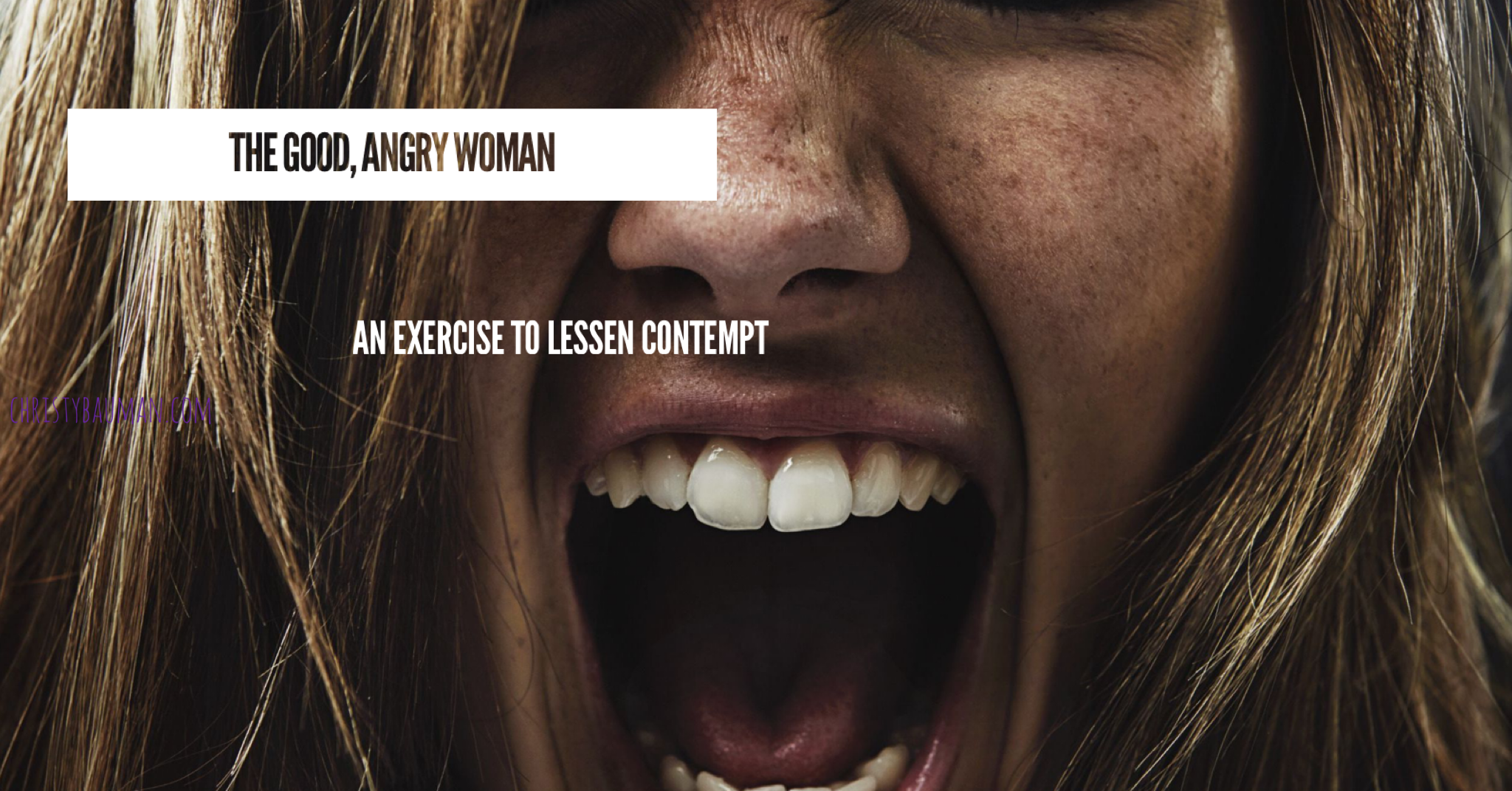
I’ve come to find that few women know how to be angry well. What I have seen in my therapy practice is that women keep their anger inside and let it fester into resentment, which becomes contempt.
Women often don’t give their bodies a chance to actually feel and move through the anger they are holding inside.
I was driving home to our mountain cabin in the woods of Western Northern Carolina in a run-down van we had just purchased for our family, and everything on the van was breaking. This stupid van had cost me a productive workday; I’d had to cancel with many clients so that I could take care of this broken down heap of metal. I was so angry with the mounting situation and the litany of negative circumstances we had encountered over the previous two months. I was angry with my husband. I was trying to be a good, supportive wife, but the weeks had been filled with stressful events and bad financial choices, and I was at my wit’s end. My phone was dead, and of course the van’s archaic radio didn’t work, so I just began to yell, loudly. I yelled, “I hate you, Andrew, I hate you!” I was shocked that I had the audacity to say those words out loud. Immediately after I said the words, I knew it wasn’t true, I didn’t hate my husband, but I sure felt like I did. My wild declaration left me feeling a little lighter, yet I had a lot more I wanted to get out, and since I was alone, I kept going. I continued yelling, I yelled things I will not share here, but I went raw and honest, and I believe that is what kept me sane. I had to say all of the things I was feeling to find out what it was I truly believed . So I yelled, “I hate this van, this stupid van, I hate this damn season of life, I hate our financial situation, I hate how tired I am, I hate how little time I have for myself, I hate it all!” It felt so good to scream as loud as I could, until my throat hurt and my eyes burned. I felt a wave of something new moving through me.
Rage started to turn into heavy disappointment. I kept going. “I am so disappointed that things have turned out this way. I am so disappointed when I look at my tired body, I am so disappointed that we are struggling right now. I am so, so disappointed that we are here in this town, with your family, with this new financial investment. I am so disappointed that this is what our life looks like.”
Honest and healthy anger will move from rage to disappointment into sadness.
I put my head on the steering wheel and tears ran down my face as I said, “I am so sad that this is how we are spending our holiday. I am sad that we are struggling in so many ways. I am sad that it isn’t easier and that there aren’t more family members who can help us, with our children or with our marriage. I am just so, so sad.” By this point, the sadness was coming in heaves of tears; so I let them come. All of that previous angst and stress in my chest was gone, it had dissipated somehow. When I was done, I got back on the road, drove home, and asked Andrew if I could talk about my difficult day after a bath. Our conversation was authentic and more gentle than I ever imagined it could be.
I am so grateful for that experience, because I know the rage and heaviness and sadness are no longer inside of me; I left them on that windy Carolina mountain road.
The exercise of pushing into my anger and then releasing my sadness freed me from its hold. I was never taught as a woman, especially a Christian woman and a good, Christian wife, how to be angry in a healthy way. I have seen many contemptuous and resentful wives come into therapy with their husbands years too late. By the time their husbands change and turn to them looking for forgiveness, the wives’ hearts have turned to stone, for they have held their anger in for far too long. It is heartbreaking to see the loss on a woman’s face when she turns and asks how to remove the contempt and hate she has felt for 20 years.
Anger is not a bad thing, aggression is. Anger is an invitation to our disappointment and ultimately to our grief.
When we honor the process and listen to our bodies, we will find freedom. Our bodies want to free us from the anger we feel inside; we were not meant to inherit the disease of contempt. I encourage you to practice this exercise whenever you find yourself angry. Go somewhere that you can be alone, and begin with the sentence, “I am angry about…” and express why you are angry at least 10 times until you really wake up your body to the fullness of your anger. What’s important to remember is that you should not stop once the anger rises to the surface; you should allow your body to move fully through the exercise. Then I invite you to move to the statement, “I am disappointed…” which you will say at least 10 times. When your body feels like you’re finished with the disappointment stage you will know, because sadness will come. The tears will tenderize you towards the third and final stage. Finish by expressing your sadness, “I am sad…” 10 times.
1. I am angry....(10x)
2. I am disappointed.......(10x)
3. I am sad.......(10x)
Allow yourself to then let your body rest and relax. Be tender and gentle as you go about the rest of your day and, if possible, take a bath or a massage. It’s important to do some form of self-care. Doing anger well takes work and practice.
“Anything that is human is mentionable, and anything that is mentionable can be more manageable.
When we talk about our feelings, they become less upsetting, less overwhelming, and less scary.” - Mister Rogers
Sunday Mornings Are Hard For Me: Lament for Those Who Have Left The Church

“It’s you! We grew up together! You! My best friend! Those long hours of leisure as we walked arm in arm, God a third party to our conversation. My companion, my close friend; we once enjoyed sweet fellowship as we worshipped together in the house of God.” Ps.55:14
This obscure verse of lament comes back to me in the strangest moments. I don’t relate to the other verses in this chapter, but this 14th verse strikes my knowing place.
As this decade ended, so did the communal mission my friends and I started 12 years ago when we planted a church. The church still stands, the ministry continues to thrive but since the beginning, we have lost over 25 founding members. I led worship this morning and broke down because in the crowd so many new faces stared back at me. It isn’t a negative thing to have a lot of new people, but it is the absence of old faces that sucker punched me.
“....we once enjoyed sweet fellowship as we worshipped together in the house of God.”
I feel accompanied as if the writer has experienced the same loneliness.
We wounded warriors who still remain in the church bear the grief each Sunday of what was or could have been. Anyone who has known the loss of a pastor stepping down, a church community dividing or falling apart, a best friend moving away, understands the deep sting. Yet why such an invasive burning? The loss, like all loss, requires grief; but what happens when you walk back into a house of God?
When we walk into a church building, it all comes flooding back. The feelings of comfort, loss, betrayal, goodness, longing, gossip, back-stabbing, hope, and loneliness barrage our mind depending on our experience at church. The house of God is a place where markings are made - baptisms, weddings, funerals, bar mitzvahs, rights of passages we experience with our community while God observes and blesses.
My Sunday mornings are heavy these days when I walk into my church building, I feel the heaviness of the spirit of homelessness due to our church’s ministry but even more, piercing to breakthrough, is the heaviness of those who no longer attend our church.
I miss my friends, and although I can still see them occasionally, I miss their spirits joining with mine in worship, in communion, with God a third party to our conversation. I miss the tender space filled with their hearts and mine. I long for the unified mission to bring peace on earth, to be LOVE, and to hold each other through deaths as we wade through this life.
Honestly, I don’t blame the people who needed to leave the church in order to save their own faith. The term Christian and the actions of Christians have done so much more harm than I ever wanted to know about, so to bear such a title is jarring for me personally. Let’s take a political perspective, 81% of Evangelical Christians voted for Trump, and I have yet to see one act of Christianity be done by our president. If you were to ask me if I align with the “Christian” choice, I would adamantly disagree. So, there isn’t a judgment on those who can not congregate in a church building because they have been misrepresented, abused, harmed, silenced or betrayed by institutions under the name of Christ. I can offer to understand these stories but how lonely it is to gather together without the ones I had once worked together with for the kingdom to come to this earth. I weep for what has been lost by their leaving, and what could have been. I bless my grief and longing for “those long hours of leisure as we walked arm in arm, God a third party to our conversation”.
To all those who have had to leave the church, I miss you dearly, it was never meant to end this way. I am grieved by the loss. Selah.
Sex as Prayer
Amen, and let it be.
This is often how I end my prayers. And sometimes, after the work of connecting with my husband and engaging in sex, how I end my orgasm. Amen, and let it be.
Honestly, I would give up sex in a millisecond if it could heal and stop all the sexual harm this world has encountered. As a trauma and abuse counselor, my job is to dissect stories of sexual harm and abuse. I spend my hours at work with a figurative scalpel and suture kit as I extract stories of sexual hurt and objectification. Stories of sexual abuse and objectification have cost my sympathetic system years of damage. If there was a way I could give up sex to have all that harm undone, I would. Yet, God created sex knowing it would also cause so much harm. This baffles my mind and also begs me to consider what God intended sex to accomplish for good. If God made sex, I deduce that it has to have a stronger superpower than what evil has used it for. So what was God’s intention for sex? Procreation is the common answer. But procreation must be teased out, those who are for creating. The power of what we can create together with another being in sex is absolutely mind-blowing. My husband and I set an intention when we have sex. For whose sake are we engaging in this act? Sometimes we literally say, we consecrate this time of sexual connection to combat evil in this world. If our part of our glory occurs when we engage in a covenant with another, with integrity and vulnerability, and we receive pleasure - well then let the sexual creations come! Let us offer our scared and wounded bodies to the other in an act of faith that God will show up and bless each other with pleasure and a taste of heaven.
Growing up in the church, no one told me very much about how to navigate sex as a Christian woman. Truthfully, I did as I was taught and stayed a virgin until marriage, praying that would secure a healthy sexual lifetime for me and my husband. I wish it had been that easy. Why didn’t anyone explain that sex is a powerful tool in the kingdom of God? So powerful that evil has used it to harm countless amounts of people. Shouldn’t that mean God intended it for something extremely powerful?
Doctors, therapists, parents, teachers, and pastors have trouble openly talking and teaching about sex. Sex is a powerful and difficult subject to explore through the eyes of God. Most churches have little education on who is equipped to navigate the conversations of sexuality and God, other than mandating abstinence. God’s design for sex is obviously intentional and powerful, and I believe God has given us power through the holiness involved in the act of sex and pleasure. My professor and mentor for many years, Dr. Tina Schermer Sellers, is a Christian Certified Sex Therapist who trains Christian therapists on how to counsel clients around healthy sexuality. She teaches about the history and practices of the Law of Onah, laws directed mainly to men which command the man to give his wife pleasure during sexual acts, not to just think of himself. Research records these laws from the Torah, specifically outlining a sexual principle that protects women as a direct rule:
“Sexual relations should only be experienced in a time of joy. Sex for selfish personal satisfaction, without regard for the partner's pleasure, is wrong and evil. A man may never force his wife to have sex. A couple may not have sexual relations while drunk or quarreling. Sex may never be used as a weapon against a spouse, either by depriving the spouse of sex or by compelling it. It is a serious offense to use sex (or lack thereof) to punish or manipulate a spouse. Sex is the woman's right, not the man's. Although sex is the woman's right, she does not have absolute discretion to withhold it from her husband.” (Mamre, 2012, p. Kosher Sex)
These laws invite us to begin the exploration of God’s design for sex as it relates to pleasure and spirituality. It was during my first seminary class discussion that my professor mentioned that the female clitoris is the size of a pencil eraser head, but has more nerve endings than the head of the male penis. I was shocked; no one had ever told me that. She posed the question, “Why would God give women a clitoris which only has the physiological function to give pleasure?” I researched the function of the clitoris, finding it described as an extremely sensitive organ made up of erectile tissue which has thousands of nerve endings, with its central function being to produce sensations of sexual pleasure. I was stunned to confirm that the clitoris, in fact, has no function in reproduction and has 8,000 nerve endings, which is double to amount of the nerve endings on the penis. Who knew seminary could be so helpful? This information has been a stunning revelation for thousands of students and clients that I work with. We are under-educated as a Christian population about God’s design of the female body, especially concerning sexuality. How can we expect to build a healthy theology around God’s plan for sexuality if we don’t study His design of our sexual organs?
Objectification of the female body brings death. If a woman’s reproductive, life-creating body parts which are created in God’s image are objectified, it prevents her body from being engaged with the way God intended. Rob Bell describes Christian sexuality as a dance between being “angel”, a spirit without a body, or “animal”, a body that lives by basic instinct. Bell writes about how we, as believers, must live as a human, neither angel nor animal, but somewhere in between:
“Angels were here before us. Animals were here before us. When we act like angels or animals, we’re acting like beings who were created before us. We’re going backwards in creation. We’re going the wrong way…our actions, then, aren’t isolated. Nothing involving sex exists independent of and disconnected from everything around it. How we act determines the kind of world we’re creating. And with every action, we’re continuing the ongoing creation of the world. The question is, what kind of world are we creating? How we live matters because God made us human. Which means we aren’t angels. And we aren’t animals.” (Bell, R. 2007, p.63-64)
The question he asks is applicable to every person, at every juncture of life, what kind of world are we creating? In the context of our sexuality, we must ask ourselves this question. Do we see sexuality as something to fear, or have we trusted God-created sexuality as a powerful tool for creating? How do we use our sexuality for the glory of God? How do we use our bodies for creating? The secular culture leads us to believe that we are animals (i.e. over-sexualized) and often the church leads us to believe we are angels (i.e. asexual). In particular, the woman’s body through pregnancy demands us to see that sex is designed to create life. What kind of a world are you creating, one of objectification or true intimacy? Our sex life is a powerful prayer telling the story of who we believe God is and who we believe God created us to be.
What kind of world are we creating as Christians? I think the answer is displayed in our sex life.
Dr. Christy Bauman, PhD, MDFT, & LMHC is committed to helping women come into their true voice. She offers story-work consulting. She is the author and producer of her works: Theology of the Womb, Womaneering Perpetual Calendar, A Brave Lament, and the award-winning Documentary: A Brave Lament. She is a psychotherapist, supervisor, part-time professor who focuses on the female body, sexuality and theology. Christy’s work can be found at christybauman.com
Jesus and Alligator Hunting: Christianity & Rites of Passage for a Southern Louisiana Girl

L-O-S-E-R-ana. This nickname we had for where I grew up showed my true feelings as a teenager for my childhood home state. The long, sweltering hot days in the swamps of Southwest Louisiana sun were spent hiking and blazing trails with ATV 4-wheelers through unmarked woods. At the age of thirteen, it was finally my turn to use the 22-rifle and kill my first alligator. After shooting it multiple times, my brother and I took the canoe in the lake and dragged out the 5 feet, 3-inch-long, scaly beast. My rite of passage was hardly done by killing the creature, it would be truly tested as I attempted to tie the nerve-flinching creature down to our picnic table, then proceed to skin and later tan the hide of this gator. My main task, above avoiding nicks in the skinning, was to batter and fry the alligator meat to perfection for my family’s dinner that night. Many people often ask what alligator meat tastes like, and truly if battered and fried well, it tastes like a perfect balance between fried fish and fried chicken. One never wants to end up with too chewy and rubbery overcooked, fried gator bites.
This experience was one of elite rites of passage that took place over my life growing up as a Cajun girl in a town with a population of under 7,000 people. Most school holidays consisted of events such as the first day of squirrel hunting or quail hunting, and, if you were lucky, school let out early on the days we were going to a skeet shoot. There are rites of passage in everyone’s life, although they may vary based on your ethnicity, social status, religion, and other factors. Rites of passage, ceremonies, and rituals are all historical ways in which women and men have engaged with their bodies as they grow older. Rites of passage are ways of marking an important stage in one’s life or an event associated with crisis or change of status, especially birth, naming, puberty, marriage, illness, or death. Adulthood is a social construct, and sociologists emphasize that marker events are a criteria for adulthood. Celebration and rites of passage amongst the women of my family feel familiar in other areas, but very limited when it comes to sacred feminine matters, particularly puberty. My period and sex were not subjects the women in family participated in corporately. I did not think highly about the privilege of becoming a woman and the responsibility of bearing a womb. Our best attempt at building a theology around our bodies was having my momma come to help me for the two weeks after my kids were born and cook for me. Other than that, no one really ever helped me make meaning of what was happening in my developing reproductive system. No one ever tied together how my feminine body displayed the glory of God or the reflection of a Creator. I didn’t grow up spending my menstruation weeks in a tent or spa retreat somewhere in the woods with these women, but this image of a repetitious weekend with my mothers of old, cooking all day long, is the closest experience I have to what it might have looked like to be handed down a ritual, a collection of stories, recipes, and belongingness. What I learned is that at least life is hard and God never intended for us to do it alone.
On a global level, we know the most basic practice of mothers teaching their daughters to wash and brush their hair is passed down from generation to generation. These practices illustrate sisterhood, women bathing in communal bath houses such as Turkish hammam or Finnish saunas. They transcend all cultures and become rituals particular to women and evidence that our ever-bearing, female bodies were made to live amongst tribes. Historical menstrual tents consisted of multiple generations of a selected tribe. Women who were already experiencing menopause would join the menstrual tents to help the younger generations. Women who were breastfeeding would bring their nursing babes along with their daughters. All females were welcome in the week of bleeding. The time was filled with spa-like and grooming activities such as bathing, massage, hairdressing, storytelling, and dream sharing. In days of old, this ritual journey was done with your great-grandmother, grandmother, mother, aunts, sisters, and daughters. The unknowns of a woman’s body were reflected in the vast differences and similarities of the bodies in your family and your community; each body reflecting back to you that you come from one another and are connected to each other in a mysterious way. We need our tribe; our tribe reflects and reminds our bodies both who we are and that we are not alone. Even today, we need to have consistent gatherings and reflections amongst women so that we can feel less alone in our own female bodies. This historical act of sharing in a communal initiation to a girl’s menstruation has long been practiced throughout the world. Global historic rituals of girls’ first blood are overall culturally seen as negative, except for places where the ritual is done in community. For instance, in India, Hindu women tend to view menstruation, especially first menstruation or menarche, as a positive aspect of a girl's life. In South India, girls who experience their menstrual period for the first time are given presents and celebrations to mark this special occasion. Ancient Hebrew women took their girls out into the wilderness to dig a hole to bury their first blood and let replenish the earth, while young girls in Ghana sit under ceremonial umbrellas and people brings gifts and pay homage.[ii] There are even positive accounts from male religious leaders in the Ivory Coast, who describe menstruation as “the flower of a tree which needs to flower before it can bear fruit.”[iii] These other viewpoints contradict the imposed “ideology of sin, dirt, pollution” that has been given to menstruation.[2] Within the cultures which believed menstruation was a positive thing and something to be done in community, the women spoke of their time of menstruation, postpartum, nursing, and menopause in community as positive. The red tent concept a universal and important part of caring for a woman’s body through her womb’s entire life cycle. Lastly, it was a Ulithi woman of the South Pacific who explained her culture’s understanding of the red tent, where breastfeeding women join menstruating women in huts along with their children. Although it is stunning to me that this is happening present day, she explains that the tents have a “kind of a party atmosphere”.[iv]
The day I started my first period, my nanny took me to get a Coke at Sonic. There was no party, no flowers, no umbrellas or dances, and definitely no digging holes in the ground. In fact, in Southern Louisiana, my family was considered to be very progressive to be because we actually spoke about periods and sex. I came from a “good, Christian home” and went to private school, so there was no sex education for me. Luckily, one Sunday night after church my mom took my younger sister and me to Ryan’s Steakhouse Buffet and told us about sex. I will never forget how she illustrated sex with a green and red gummy bear from our dessert plate, and to this day I struggle to eat those colors. For Western Christian women, there are rituals and conversations not easily passed down, such as periods and sex, in many families even amongst the women there is silence, so we must learn about these subjects on our own, alone.
Different cultures hold different events for their communities, but these rituals teach us the importance of marking our moments of celebration and grief. Martin Prechtel’s words beckon me to continue to mark my life events through ceremonies and rituals. He says, “Rites-of-passage ceremonies are not just for young people to pass into adulthood. Life change ritual
s should accompany every stage of life and anticipate the people’s full expression of grief.” The word grief stands out to me. Do rites of passage express grief? Nikki Giovanni’s interview rushes into my mind, her words echoed this thought, “For something to live, something must die”.[ii] When I began the study of a woman’s womb and the rites of passage engaged in the process of monthly menstruation and births, I never anticipated God’s invitation to the grief one must bear for something new to become alive. This is the emotional significance of living continuously through these rites of passage our bodies ask us to engage.[iii]




